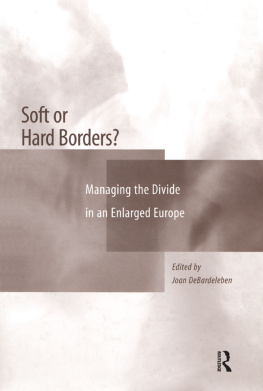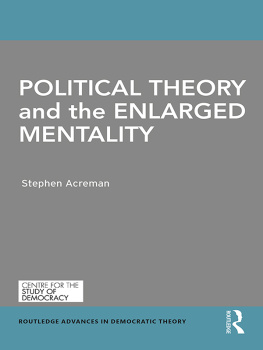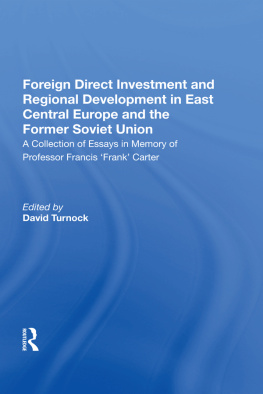SHOCK-SHIFT IN AN ENLARGED EUROPE
Shock-Shift in an Enlarged Europe
The geography of socio-economic change in East-Central Europe after 1989
Edited by
F.W. CARTER
Department of Social Sciences
School of Slavonic and East European Studies, University of London
and
W. MAIK
Department of Social Geography and Tourism
Nicholas Copernicus University, Toru
First published 1999 by Ashgate Publishing
Reissued 2018 by Routledge
2 Park Square, Milton Park, Abingdon, Oxon, OX14 4RN
711 Third Avenue, New York, NY 10017, USA
Routledge is an imprint of the Taylor & Francis Group, an informa business
Copyright F.W. Carter and W. Maik 1999
All rights reserved. No part of this book may be reprinted or reproduced or utilised in any form or by any electronic, mechanical, or other means, now known or hereafter invented, including photocopying and recording, or in any information storage or retrieval system, without permission in writing from the publishers.
Notice:
Product or corporate names may be trademarks or registered trademarks, and are used only for identification and explanation without intent to infringe.
Publishers Note
The publisher has gone to great lengths to ensure the quality of this reprint but points out that some imperfections in the original copies may be apparent.
Disclaimer
The publisher has made every effort to trace copyright holders and welcomes correspondence from those they have been unable to contact.
A Library of Congress record exists under LC control number: 98074443
ISBN 13: 978-1-138-35206-3 (hbk)
ISBN 13: 978-0-429-43490-7 (ebk)
Contents
F. W. Carter and W. Maik
Zbyszko Chojnicki, Teresa Czyand Jerzy J. Parysek
Martin Hampl and Jan Mller
Jn Paulov
Marijan M. Klemeni
Andr-Louis Sanguin
Claudia Popescu
A. Marksoo
Andrzej Werwicki
Andrew H. Dawson
Andrew Tickle
John Sargent
Adrian Smith
David Turnock
George Prvlakis
Tim Unwin
M. J. Bradshaw
F. W. Carter and W. Maik
M. J. Bradshaw
School of Geography, University of Birmingham
F. W. Carter
Dept of Social Sciences, School of Slavonic and East European Studies, University of London
Zbyszko Chojmcki
Institute of Socio-Economic Geography and Spatial Planning, Adam Mickiewicz University, Pozna
Teresa Czy
Institute of Socio-Economic Geography and Spatial Planning, Adam Mickiewicz University, Pozna
Andrew H. Dawson
Dept of Geography, University of St Andrews
Martin Hampl
Dept of Social Geography, Charles University, Prague
Marijan M. Klemeni
Dept of Geography, Ljubljana University
W. Maik
Dept of Social Geography and Tourism, Nicholas Copernicus University, Toru
A. Marksoo
Institute of Geography, University of Tartu
Jan Mller
Dept of Social Geography, Charles University, Prague
Jerzy J. Parysek
Institute of Socio-Economic Geography and Spatial Planning, Adam Mickiewicz University, Pozna
Jn Paulov
Dept of Regional Geography, Landscape Protection and Planning, Comenius University, Bratislava
Claudia Popescu
Institute of Geography, Romanian Academy of Sciences, Bucharest
George Prvlakis
Institute of Geography, University of Paris-IV, Paris
Andr-Louis Sanguin
Dept of Geography, University of Angers
John Sargent
Dept of Geography, School of Oriental and African Studies, University of London
Adrian Smith
School of Social Sciences, University of Sussex
Andrew Tickle
Centre for Extra-Mural Studies, Birkbeck College, University of London
David Turnock
Dept of Geography, University of Leicester
Tim Unwin
Dept of Geography, Royal Holloway College, University of London
Andrzej Werwicki
Institute of Economic Geography and Spatial Organization, University of Lodz
The editors would like to thank the British Academy for a grant towards the production of camera-ready copy for this book, and John Andrew for his sterling work in completing this vital task. During our stay in Poland the generous hospitality offered by the Geographical Institute at the Nicholas Copernicus University in Toru is gratefully acknowledged, together with the warmth and friendliness of officials at Toru County Hall, the Mayor and his colleagues at Toru City Hall, and staff at the Regional Centre for the Study and Protection of the Cultural Environment in that city. We should also like to acknowledge the efforts made by British colleagues from the conference for their help in improving the linguistic presentation of some of the texts. Finally, Professor Hampl and Dr Mller would like to acknowledge the receipt of financial support from the Czech Grant Agency (Grant Number 205/93/0823) which enabled them to carry out research for their chapter.
F. W. CARTER and W. MAIK
This book is devoted to a geographical analysis of problems associated with socio-economic changes taking place in East-Central Europe. These problems have resulted from the demise of the Communist order and transition of these countries to a market economy and a democratic system. The idea behind this volume is to provide a confrontation of two viewpoints the major chapters are written by East European scholars, followed by discussions held with their Western European counterparts. The idea was to provide depth and clarity to the debate on understanding those geographical problems facing the emerging East European states nearly a decade after the fall of the Iron Curtain.
The volume results from contributions made by colleagues at a geographical conference held in Toru, Poland, in late 1994. A summary of the content of these papers written by East European colleagues highlighted the regional imbalance found in Poland, the Czech Republic and Slovakia through papers by Zbyszko Chojnicki and his colleagues, Martin Hampl and Jn Paulov, with the most vigourous changes found in these countries western regions and metropolitan areas. Claudia Popescu discovered that in Romania the more developed industrial regions had witnessed a more vibrant privatization process giving them an enhanced economic status over the rest of the country. Regional growth centres and the significance of southern rural fringe areas were seen as meaningful in both Estonia (A. Marksoo) and Slovenia (Marijan M. Klemen i). A tendency towards agglomeration was clearly visible in Estonian towns such as Narva, Prnu and Tartu, largely resulting from the vulnerability of local rural centres to agricultural privatization and the demise of giant farm organizations formerly linked to extensive rural centres. In Slovenia, programmes aimed at revitalizing underdeveloped zones were being undertaken through infrastructural investment and attempts at rejuvenating social organization.












